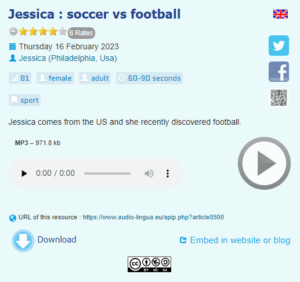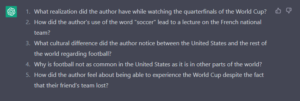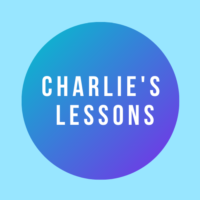Today I’m sharing with you a free audio resource that’s going to help your students start improving their listening skills today.
The name of the website is Audio Lingua, you can find this at audio-lingua.eu. You can even navigate the website in lots of different languages so if you’re teaching English then ask your students to use it in English. There are nearly 2,000 resources and they are all free.
Where to find the free audio resource
Let’s take a look at an example recording. We have a title, a rating set by the users who are registered at the website, the date of the recording, the name of the person speaking and importantly where that person is from. There are also some helpful tags like the level, the gender, the age, the length and any associated topics. If you’d like to search for something specific, on the right-hand side we can search by keywords or do an advanced search. We can look for recordings of a certain level, gender, age or length.
You can download all of the recordings onto your computer or onto your mobile phone which is important as you’ll see later.

First idea on using it in class
The first way I use this website in my classroom is to do a prediction task. I look at the title of a listening and I get my students, first in pairs or groups, to predict what vocabulary or expressions they’re going to hear. As an example I’ve got Sophie who’s from Ohio, USA. She’s talking about her favourite streaming platforms for watching movies. I’ll ask my students to think about;
- vocabulary related to watching movies online
- the different genres of movies
- how often she watches movies,
- film or movie that she may have watched recently and what language she is going to use to describe it
Once a pair or group has decided that they are happy with the list of expressions or vocabulary, we then listen and we match any vocabulary or expressions in their list with any vocabulary or expressions in the recording. Usually, I would give a prize to the pair or group who matched the most expressions. The teacher would also be making notes of any useful language or expressions that are related to the topic and introducing some of this new vocabulary to your students especially if they did not predict it in the listening section.
Grab the download
If you like these ideas and you’d like some more websites and more ideas for your class then check out this download right here.
It includes four other websites with even more ideas you can get started with in your classroom.
Second idea on using it in class
My second idea is solving the problem that this website audiolingua.eu does not contain any transcripts. These are really useful because it means we can create questions or search for useful language for our students. However, I’ve found a way of creating a transcript for free!
Download an MP3 of any recording from audio lingua onto your mobile. Open a Google doc, go to tools and go to voice typing. Once the voice typing option is up then there should be a picture of a microphone. Activating this will mean your PC or laptop will start recording whatever is played to it. Play the recording from your phone to the computer and you’ll start to see a transcript appear on the blank document.
This software is not foolproof so there may be some sentences or phrases that do not get picked up, but it will pick up the majority of what is being said. With the transcript ready, I can now go to ChatGPT.
Take the text here and paste it into the text box after asking ChatGPT to write five comprehension questions.

If you haven’t used ChatGPT before then go check out my post right here, which will go through not only the basics but also how you ask questions to ChatGPT.
Copy these questions and pop them into a Google doc and you’ll be able to use these in your next class. There are lots of other types of questions that you can create for example; multiple choice or gap-fills. There’s no limit on what kind of questions you can ask ChatGPT to produce for any given transcript.
Don’t forget that if you liked these ideas, then check out this download right here. It includes four other websites with even more ideas you can get started with in your classroom.
Thank you for reading about this great listening resource for your students and I hope you find it useful.
